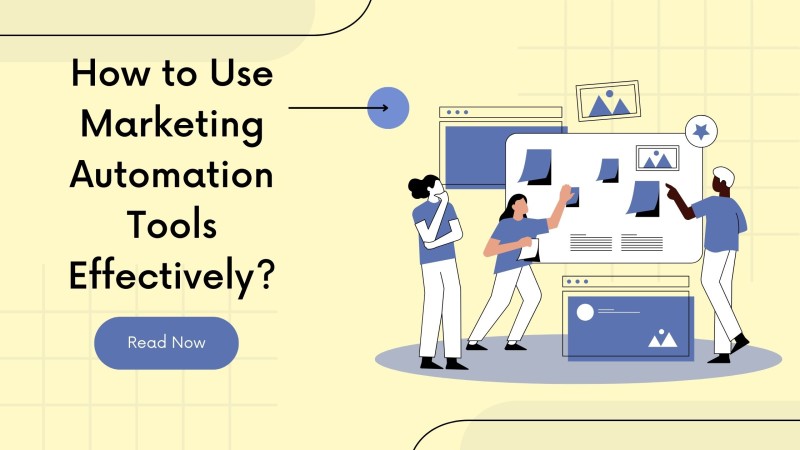
How to Use Marketing Automation Tools Effectively?¶
In today's fast-paced digital landscape, marketing automation tools have become indispensable for businesses of all sizes. These tools streamline and automate various marketing tasks, enabling marketers to save time, improve efficiency, and deliver personalized experiences to their target audience. However, to reap the maximum benefits from marketing automation tools, it's crucial to understand how to use them effectively. In this article, we will explore key strategies and best practices for leveraging marketing automation tools to drive successful marketing campaigns.
1. Define Your Goals and Objectives¶
Before implementing any marketing automation tool, it's essential to define clear goals and objectives. Determine what you want to achieve through automation, whether it's increasing lead generation, improving customer retention, driving sales, or enhancing customer experience. By having specific goals in mind, you can align your automation efforts and select the right tools that align with your objectives.
2. Segment Your Audience¶
Segmentation is a powerful feature offered by marketing automation tools. It allows you to divide your audience into distinct groups based on criteria such as demographics, behavior, interests, or engagement level. By segmenting your audience, you can deliver highly targeted and personalized messages that resonate with each group, increasing the effectiveness of your marketing campaigns.
3. Nurture Leads with Drip Campaigns¶
Marketing automation tools enable you to set up drip campaigns, which are automated email sequences delivered to prospects or customers at predefined intervals. Create a series of relevant and valuable content that guides your leads through the buyer's journey. Drip campaigns help nurture leads, build trust, and increase the likelihood of conversions. Ensure your content is engaging, educational, and tailored to the specific needs of each segment.
4. Implement Lead Scoring¶
Lead scoring is a valuable feature that allows you to assign a numerical value to each lead based on their behavior, engagement level, and demographics. It helps you identify and prioritize leads that are most likely to convert or require immediate attention. By implementing lead scoring, you can focus your efforts on high-quality leads, effectively allocate resources, and improve overall conversion rates.
5. Use Dynamic Content¶
Marketing automation tools often provide the capability to deliver dynamic content that adapts based on individual preferences, behavior, or demographic information. Leverage this feature to deliver personalized content experiences to your audience. Tailor email content, website messaging, or product recommendations based on their interests, previous interactions, or stage in the buyer's journey. Personalization can significantly enhance engagement and drive conversions.
6. Integrate with CRM Systems¶
To fully leverage the power of marketing automation, integrate your automation tools with customer relationship management (CRM) systems. This integration allows for seamless data exchange between marketing and sales teams, enabling better lead management and improved communication. By syncing data between the two systems, you can gain a holistic view of your customers, track their interactions, and ensure a consistent experience throughout the customer lifecycle.
7. Analyze and Optimize¶
Regularly analyze the performance of your marketing automation efforts and make data-driven optimizations. Monitor key metrics such as email open rates, click-through rates, conversion rates, and customer retention. Identify areas where you can improve engagement and conversions, and experiment with different approaches. A/B testing can be valuable for optimizing email subject lines, call-to-action buttons, landing pages, or workflows.
8. Provide Ongoing Training and Support¶
To maximize the effectiveness of marketing automation tools, invest in ongoing training and support for your marketing team. Ensure they have a thorough understanding of the tools' capabilities, best practices, and overall marketing strategy. Provide regular training sessions, workshops, or access to educational resources. Encourage collaboration and knowledge sharing among team members to continuously enhance their automation skills.
9. Utilize Behavior-Based Triggers¶
Take advantage of behavior-based triggers within your marketing automation tools. These triggers allow you to automate actions based on specific actions or behaviors exhibited by your leads or customers. For example, you can set up triggers to send follow-up emails when a lead interacts with a particular piece of content or make personalized recommendations based on their browsing behavior on your website. Behavior-based triggers enable you to deliver timely and relevant messages that resonate with your audience.
10. Integrate with Social Media Platforms¶
Extend the reach of your marketing automation efforts by integrating your tools with social media platforms. This integration allows you to automate social media posting, schedule content in advance, and track engagement metrics. By maintaining an active presence on social media and automating certain tasks, you can consistently engage with your audience, drive traffic to your website, and increase brand visibility.
11. Implement Lead Capture Forms¶
Marketing automation tools often come with lead capture form capabilities. Use these forms strategically on your website to capture valuable information about your leads. Optimize your forms by keeping them concise, offering incentives for form completion, and ensuring they are mobile-friendly. The data collected through lead capture forms can be used to further personalize your marketing efforts and provide a seamless customer experience.
12. Conduct A/B Testing¶
A/B testing is a powerful technique that allows you to compare two versions of a marketing asset to determine which one performs better. Test different elements such as email subject lines, call-to-action buttons, landing page designs, or content variations. Through A/B testing, you can gain insights into what resonates best with your audience and make data-driven decisions to optimize your marketing campaigns for better results.
13. Automate Lead Nurturing Workflows¶
Create comprehensive lead nurturing workflows within your marketing automation tool. These workflows can include a series of automated actions and communications that guide leads through the different stages of the buyer's journey. Map out the touchpoints and interactions you want to have with your leads, and set up automated emails, reminders, or other actions to keep them engaged and moving closer to conversion. Lead nurturing workflows help build relationships with your leads, provide valuable information, and increase the chances of conversion.
14. Monitor and Measure Results¶
Regularly monitor and measure the results of your marketing automation efforts. Leverage the analytics and reporting features of your automation tool to track key metrics, such as conversion rates, customer lifetime value, email engagement, and ROI. By analyzing these metrics, you can identify areas of improvement, optimize your strategies, and ensure that your automation efforts are aligned with your business goals.
15. Stay Updated with New Features and Trends¶
Marketing automation tools are continually evolving, with new features and functionalities being introduced regularly. Stay informed about updates and new releases from your tool provider. Attend webinars, conferences, or workshops related to marketing automation to stay up-to-date with the latest trends and best practices. By staying informed and embracing new features, you can unlock additional capabilities and stay ahead of the competition.
What Are The Different Marketing Automation Tools?¶
- HubSpot:
HubSpot offers a full suite of marketing automation tools, including email marketing, lead nurturing, and CRM integration.
- Mailchimp:
Mailchimp is known for its email marketing and automation features, making it easy to create and send email campaigns.
- Marketo:
Marketo is a robust marketing automation platform that caters to both B2B and B2C marketing needs.
- Pardot:
Owned by Salesforce, Pardot is a B2B marketing automation tool that helps with lead generation and nurturing.
- ActiveCampaign:
ActiveCampaign offers automation features for email marketing, CRM, and marketing automation.
- Infusionsoft (now Keap):
Infusionsoft by Keap is designed for small businesses and offers automation for email marketing and customer management.
- Eloqua:
Oracle Eloqua is a marketing automation platform suitable for large enterprises, offering advanced features for lead scoring and nurturing.
- GetResponse:
GetResponse is an all-in-one marketing platform that includes email marketing, automation, and landing page creation.
- ConvertKit:
ConvertKit is a popular choice for bloggers and content creators, with features like email marketing and automation.
- Drip:
Drip specializes in e-commerce marketing automation, helping online retailers personalize their customer communications.
- SharpSpring:
SharpSpring is a marketing automation tool designed for agencies and small to medium-sized businesses.
- Autopilot:
Autopilot offers visual automation workflows for email marketing, lead nurturing, and customer journey mapping.
- Customer.io:
Customer.io is an email marketing automation tool that focuses on behavior-based messaging.
- Ontraport:
Ontraport provides marketing automation, CRM, and business process automation for entrepreneurs and small businesses.
- SendinBlue:
SendinBlue is an all-in-one marketing platform that includes email marketing, SMS marketing, and marketing automation.
Conclusion¶
Marketing automation tools offer immense potential for streamlining marketing processes, enhancing customer experiences, and driving business growth. By defining clear objectives, segmenting your audience, nurturing leads with drip campaigns, implementing lead scoring, using dynamic content, integrating with CRM systems, analyzing performance, and providing ongoing training and support, you can effectively leverage these tools to achieve your marketing goals. Stay updated with the latest automation trends and continuously optimize your strategies to stay ahead in the dynamic digital landscape.
 Dolly Solanki
Dolly Solanki
![]() Want to Share Your Views? Have Any Suggestions?
Want to Share Your Views? Have Any Suggestions?
If you want to
- provide some suggestions on topic
- share your views
- include some details in tutorial
- suggest some new topics on which we should create tutorials/blogs
Want to Get your Website on the First Page of Google SERP?
Reach out to CoderzColumn's digital marketer Dolly Solanki (dollyborade07@gmail.com). We can help you get a better ranking for your website.



 Want to Share Your Views? Have Any Suggestions?
Want to Share Your Views? Have Any Suggestions? automationtools, seo, searchengineoptimization, digitalmarketing, SMM, leadgeneration, businessleads, mailchimp, automation, autopilottools
automationtools, seo, searchengineoptimization, digitalmarketing, SMM, leadgeneration, businessleads, mailchimp, automation, autopilottools
